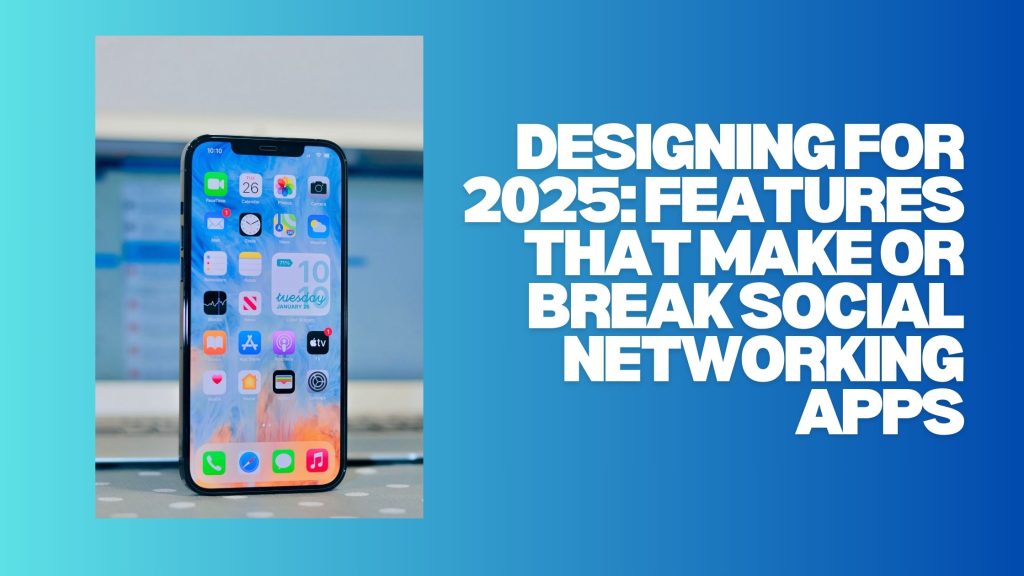Social networking apps have transformed the way we communicate and connect. They are no longer just platforms for sharing photos or status updates; they shape our relationships, influence trends, and even impact society at large. As we look toward 2025, the competitive landscape of these apps is evolving rapidly. With new technologies emerging and user expectations shifting, app developers must stay ahead of the curve to capture attention in a crowded market.
The race isn’t merely about functionality anymore; it’s about crafting experiences that resonate deeply with users. What will define success in this digital age? Let’s explore some pivotal features that can make or break social networking apps as we approach 2025.
User Experience and Interface Design Trends for 2025
User experience and interface design are evolving rapidly as we approach 2025. Clean, minimalistic layouts will dominate social networking apps. Users want simplicity without clutter.
Micro-interactions will play a crucial role in keeping engagement high. Subtle animations can make actions feel more intuitive and rewarding. Every tap should have feedback that resonates with users.
Voice user interfaces (VUIs) are becoming essential too. As voice technology improves, integrating it into app navigation can enhance accessibility for all demographics.
Dark mode isn’t just a trend; it’s now an expectation for many users who seek comfort during nighttime browsing sessions. Customization options allow individuals to tailor their experiences further.
Inclusive design principles will gain traction, making apps usable for everyone regardless of ability or background. Emphasizing empathy in design ensures no one is left behind in the digital space.
The Impact of Augmented Reality and Virtual Reality on Social Media Platforms
Augmented reality (AR) and virtual reality (VR) are transforming social networking apps in remarkable ways. These technologies enhance user interactions, creating immersive experiences that capture attention.
Imagine attending a concert with friends from around the world while sitting in your living room. That’s the power of VR integrated into social platforms. Users can connect in shared spaces, blurring geographical boundaries.
AR adds another layer by allowing users to superimpose digital elements onto their physical surroundings. Think filters that let you try on outfits or effects that bring photos to life. This not only boosts engagement but also encourages creativity among users.
As these technologies evolve, they will redefine how we communicate and share moments online. Social networking apps must prioritize seamless integration of AR and VR for a more engaging experience, fostering deeper connections among communities worldwide.
Personalization and Customization in Social Networking Apps
Personalization is the key to enhancing user engagement in social networking apps. Users crave experiences tailored specifically to their preferences.
Imagine an app that learns your interests over time and curates content accordingly. This level of customization keeps users coming back for more, fostering a sense of belonging.
From profile themes to customized feeds, the options for personalization are endless. Features like mood-based filters or interest-specific groups create unique environments where users feel at home.
Moreover, allowing users to choose what they want to see helps build trust. When individuals can shape their experience, they’re more likely to share and engage within the platform.
As we move towards 2025, integrating AI-driven suggestions will take this concept even further. An intuitive system that adapts in real-time will be essential for standing out in a crowded market.
The Rise of Ephemeral Content and its Role in App Design
Ephemeral content has transformed how users interact on social networking apps. This short-lived format captivates audiences by creating a sense of urgency. Posts disappear after 24 hours, prompting quick engagement and spontaneity.
Designing for this type of content requires simplicity and immediacy. Users should easily capture moments or share stories without navigating complex features. The interface must highlight the fleeting nature of these posts, encouraging creativity while avoiding clutter.
Incorporating engaging elements like stickers, filters, and interactive polls can enhance user experience. These features not only make sharing more fun but also foster community interaction.
As trends evolve, ephemeral content encourages authenticity among users. It allows them to express themselves freely without the pressure of permanence in their online profiles. This trend is essential in keeping social networking platforms relevant and appealing to younger audiences seeking genuine connections.
Privacy and Security Considerations for Future Social Networking Apps
As social networking apps evolve, privacy and security concerns take center stage. Users are increasingly wary of how their data is used and shared.
Future app designs must prioritize transparent data practices. Clear policies can build trust between users and platforms. Simple language will help demystify complex terms.
Data encryption should become a standard feature. It protects user information from unauthorized access, ensuring peace of mind while engaging on the platform.
Two-factor authentication adds another layer of protection against breaches. Encouraging users to enable this feature could significantly reduce risks.
Moreover, implementing robust reporting tools allows users to flag inappropriate content or behaviors easily. This creates a safer online space for everyone involved.
Giving users control over their own data fosters empowerment and encourages active participation in shaping their digital experience without compromising safety.
The Role of Artificial Intelligence in Enhancing User Experience
Artificial intelligence is reshaping the landscape of social networking apps. It tailors experiences to individual users, making interactions more engaging and relevant.
AI algorithms analyze behavior patterns, suggesting content that resonates with users’ interests. This personalization fosters deeper connections within networks.
Chatbots powered by AI enhance communication by providing instant support. They respond efficiently to user inquiries, keeping engagement levels high without overwhelming human resources.
Moreover, AI-driven moderation tools help maintain a safe environment. They can detect harmful content swiftly, ensuring that conversations remain positive and respectful.
The integration of machine learning allows social networking platforms to evolve continuously. As they gather data over time, these systems improve their understanding of user preferences and behaviors.
With AI at the core, social networking apps will become more intuitive spaces where users feel valued and understood in their digital communities.
Conclusion: Embracing Innovation for Successful Social Networking App
Embracing innovation is key to the success of social networking apps in 2025 and beyond. As technology evolves, so do user expectations. Social media platforms must adapt quickly to remain relevant and engaging.
The integration of augmented reality and virtual reality can transform how users connect with each other. Imagine attending a virtual concert with friends scattered across the globe or exploring new places through immersive experiences. These features will redefine interaction on social networks.
Personalization stands out as another crucial element. Users crave tailored content that resonates with their interests and preferences. Developers should focus on creating algorithms that enhance individual experiences rather than generic feeds.
The trend towards ephemeral content continues to grow, influencing design choices for future apps. This temporary nature appeals to younger audiences who seek authenticity over permanence, leading designers to reimagine how information is shared and consumed.
Privacy concerns loom large in today’s digital landscape, necessitating robust security measures within these applications. Building trust through transparent practices will be essential in fostering long-term engagement among users.
Artificial intelligence offers immense potential for enhancing user experience within social networking apps. From smarter chatbots providing instant support to advanced analytics predicting trends, AI can help create more intuitive interactions.
As new technologies emerge and user preferences shift, embracing these innovations will empower developers to build successful social networking apps that resonate deeply with their communities while meeting evolving demands.

